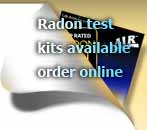
You've found radon in your home - what should you do?
First, don't panic!
Radon is everywhere and fixing a radon problem is very straight-forward.
Second...
... if you have performed only a single test, the US EPA recommends a followup test before fixing your home. Radon levels fluctuate naturally and it is important to know if the initial test was an accurate assessment of your home's average radon level or whether the high levels could have been caused by unusual weather.
How To Follow Up Your First Test
If your first test has a result between 4 and 8 pCi/L, you have the choice of testing again. If results are needed quickly, you can re-test with a short-term (2-7 days) device. For a better understanding of your home's year-round average, you can test with a long-term (3-12 months) device.
If the results of your first test are higher than 8 pCi/L, then it is recommended that you test again using another short-term test device. The higher the radon concentration above 8 pCi/L, the sooner you should conduct a retest.
Interpreting Your Follow Up Results
If you are involved in a real estate transaction, the EPA recommends fixing the house prior to sale if the average of your original and follow-up tests are 4.0 pCi/L or higher.
If you chose a long-term device for your second test, the EPA recommends fixing your home if the follow-up result is 4.0 pCi/L or higher.
If the results of your followup test with a short-term test are still 4.0 pCi/L or higher, you are urged to consider fixing your home.
If your followup test results are below the 4.0 pCi/L EPA action level, you should test again sometime in the future because your initial test has shown that your house has the potential to produce high radon levels at times.
Radon Mitigation
If you have performed a follow-up test and the radon level needs to be reduced, you have several options.
If you want to hire a professional, qualified radon mitigation contractors are available across the country. Some states require contractors maintain a state license, so you may want to contact your state radon office for a list of qualified individuals. Although most states do not require licenses, it is very important to use a properly-trained mitigator. The National Environmental Health Association (NEHA) administers a voluntary National Radon Proficiency Program (NRPP) for radon professionals who want to take training courses and examinations to demonstrate their competency. The NEHA NRPP website maintains lists of certified radon mitigators, radon measurement service providers, and analytical laboratories. Follow the link, choose the service you seek and then narrow your search by state.
If you or a friend are a do-it-yourselfer, Air Chek offers a do-it-yourself radon reduction manual written by Doug Kladder, one of the country's most experienced radon mitigators. Kladder also teaches introductory-level radon mitigation courses. His book features chapters on different building foundations (basement, crawl space, slab on grade), as well as new construction approaches to prevent radon entry into new homes. View the Table of Contents to get an idea of what's inside. The book can be purchased online for only $39.95, including shipping and handling. You can use our secure online order site or you can call us at 800-AIR-CHEK during regular business hours. You can also mail a check or money order to Air Chek, Inc., PO BOX 2000, Naples, NC 28760.
Kladder also created the EPA slide show on our website, which has a unit on mitigation approaches.
If you are looking for some DIY mitigation supplies and detailed how-to instructions, check out: Infiltec, Inc.